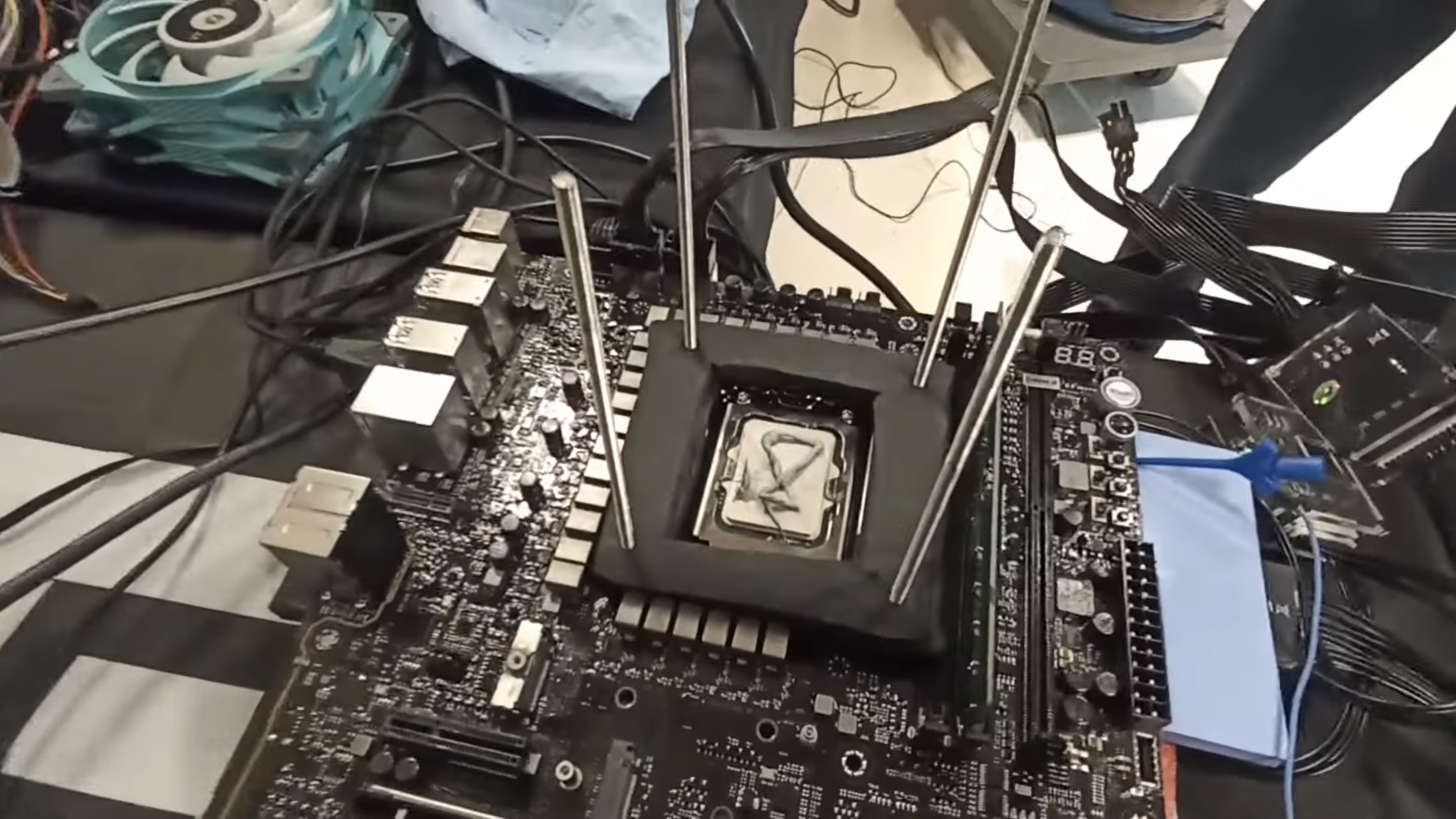Core i9-14900KS overclocked to 9.1 GHz, breaking numerous world records

Intel's latest Core i9-14900KS quickly became one of the best CPUs for enthusiasts. The special-edition 14th Generation Raptor Lake Refresh chip is also fun to overclock, as an elite team of overclockers at Asus has overclocked it to 9,117 MHz on a single performance core and broken various world records.
The Core i9-14900KS already features an impressive 6.2 GHz boost clock, the highest of any consumer processor. However, what's even more outstanding is that a team of talented individuals, including Swedish overclocker Elmor, SkatterBencher, and Shamino, managed to overclock the 24-core chip to 9,117 MHz on a single P-core. Of course, this feat is pure marketing, since a processor can't execute those speeds in a real-world scenario. However, in the overclocking world, the Core i9-14900KS just needs to be stable enough to finish the benchmarks.
To get to 9,117 MHz, the overclocking team had to crank the voltage on the Core i9-14900KS up to 1.85V and cool the chip with liquid helium down to -231 degrees Celsius to prevent the chip from kicking the bucket. As an Asus-sponsored endeavor, the team utilized the company's ROG Maximus Z790 Apex Encore, an upgraded version of the previous ROG Maximus Z790 Apex.
The team established four new world records. At 9,117 MHz, the Core i9-14900KS is the fastest processor, surpassing the previous Core i9-14900KF, which reached 9,043.92 MHz. Meanwhile, South Korean overclocker safedisk set new world records for the PiFast, SuperPI 1M, and PYPrime 32B benchmarks.
Other motherboard vendors also have their preferred extreme overclockers working on Core i9-14900KS overclocks. We'll likely see more world records in a few hours, and the ranking will likely change. But in the meantime, Elmor's Core i9-14900KS holds the highest frequency for a processor.
Intel has set a $689 MSRP for the Core i9-14900KS, which is, in theory, 15% more expensive than the regular Core i9-14900K ($599 MSRP). However, the latter often sells for nearly $550, bumping the premium to 25%. However, Core i9-14900KS pricing varies from one retailer to another. Newegg, for instance, sells the Core i9-14900KS for $729.99, whereas B&H Photo Video has the chip for preorder at $699.99, just slightly above Intel's MSRP.
The Core i9-14900KS won't make sense for most consumers. The processor is borderline faster than the Core i9-14900K, forcing you to pay $25 more for the minimal boost clock speed enhancements. AMD's Ryzen 7 7800X3D provides way more value for gamers than the Core i9-14900KS, and the Ryzen 9 7950X, which is cheaper, is superior in terms of productivity.
Get Tom's Hardware's best news and in-depth reviews, straight to your inbox.

Zhiye Liu is a news editor, memory reviewer, and SSD tester at Tom’s Hardware. Although he loves everything that’s hardware, he has a soft spot for CPUs, GPUs, and RAM.
-
funguseater Please ensure overclocks take place at night to reduce the risk of rolling blackouts...Reply -
bolweval Reply
a space heater uses 4x the wattage at a much longer duration…funguseater said:Please ensure overclocks take place at night to reduce the risk of rolling blackouts... -
TerryLaze Reply
With cooling that extreme CPUs usually draw samish or lower amounts of power as "normal" since they don't have to fight as many electrons to go from point a to b.funguseater said:Please ensure overclocks take place at night to reduce the risk of rolling blackouts...
Time marked, 9:21 in this video.
FnwhYEUHw7k:561View: https://youtu.be/FnwhYEUHw7k?t=561 -
gg83 This is pretty incredible. Liquid helium is crazy. What about using the void of outer space, on the dark side of the moon. Wouldn't that let you get the best thermal exchangeReply -
TerryLaze Reply
Yeah, but the roundabout lag would kill performance, you need your CPU to be close to you.gg83 said:This is pretty incredible. Liquid helium is crazy. What about using the void of outer space, on the dark side of the moon. Wouldn't that let you get the best thermal exchange
Even for commercial use there are only limited things that don't need good response time. -
mwm2010 Reply
The problem with using space as a cooler is that space is a bad conductor. If it was, the Apollo 11 lunar lander might have had the computer on the outside.gg83 said:This is pretty incredible. Liquid helium is crazy. What about using the void of outer space, on the dark side of the moon. Wouldn't that let you get the best thermal exchange -
gg83 Reply
Exactly what I was thinking. You need a way for the temp to exchange? I think with people in space the moisture is responsible. And it's wasted I assume.mwm2010 said:The problem with using space as a cooler is that space is a bad conductor. If it was, the Apollo 11 lunar lander might have had the computer on the outside.